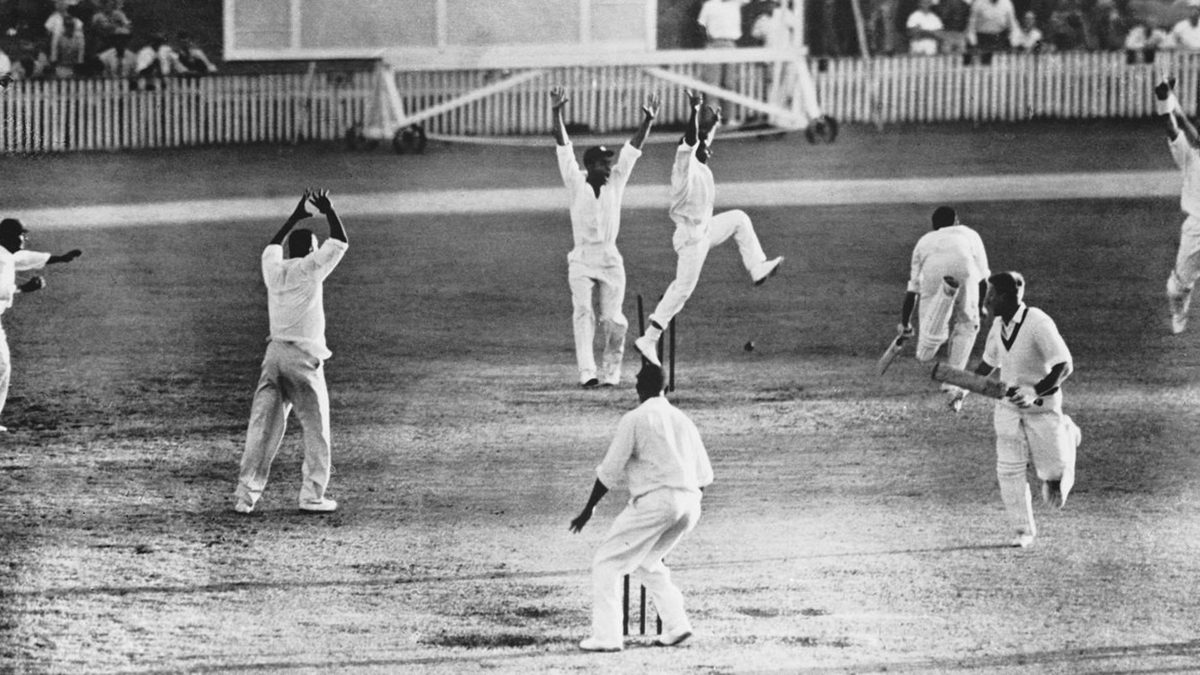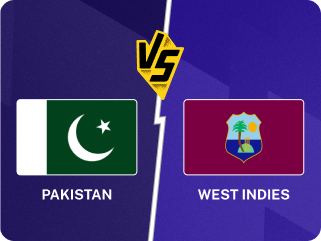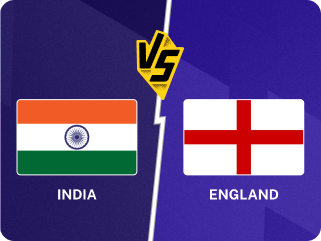
The first ever Frank Worrell Trophy, in 1960/61, was not merely a great Test series but the greatest ever, explains Abhishek Mukherjee.
The first ever Frank Worrell Trophy was the greatest Test series ever played. It is not just about the cricket – though there was plenty of that, of the highest order. The first Test match, in Brisbane, was a tie, the first in the history of Test cricket. Garry Sobers made a famous 132, Norm O’Neill responded with 181, Wes Hall warmed up with a fifty before taking nine wickets, and Alan Davidson (44, 5-135, 80, 6-87) became the first to score a hundred runs and take ten wickets in a men’s Test match.
None of that, however, captured the topsy-turvy last eight balls of cricket – featuring three outstanding throws (all of which resulted in run outs), a dropped catch, a dive to prevent overthrows, and one of the most iconic photographs in cricketing history, replete with a back-story of its own.
The best batter, bowler, and fielder of a bilateral Test series between the two teams are still awarded trophies named after Davidson, Sobers, and Joe Solomon – the man whose throw completed the tie. The “most outstanding individual performance of the series” wins the Norm O’Neill Award.
The second and third Test matches featured ‘normal’ wins – for Australia in Melbourne, West Indies in Sydney. Then, in Adelaide, Australia were nine down with an hour and fifty minutes to play. Ken Mackay and Lindsay Kline played out time.
In the decider, again in Melbourne, Australia were set 258. They were 254-7 when Wally Grout late cut Alf Valentine and ran two – with a bail lying on the ground. Grout was ruled not out, but was dismissed ‘again’ immediately. Then Johnny Martin was dropped, and Australia won by two wickets.
Test cricket will turn a century and a half in a few years, yet few series have been this keenly contested. A tie, a draw with one wicket left to get, and a two-wicket win.
The cricketers, many of them superstars of the past or future, lit up the series. Lance Gibbs took 19 wickets in three Test matches – and that included a hat-trick. O’Neill’s hundred remained Australia’s only one of the series – but ten different batters scored fifties, along with nine from the touring side.
Gerry Alexander scored a fifty in each Test match and held 16 catches; Grout, his Australian counterpart, effected 23 dismissals. Australian captain Richie Benaud finished with 23 wickets and Hall 21. Rohan Kanhai made two hundreds, Bob Simpson four fifties. Towering over them were Sobers (430 runs, 15 wickets, 12 catches) and Davidson (212 runs, 33 wickets).
And it was not merely about the results or performances either.
A new way of playing
Since the Second World War, Test cricket had entered a phase of caution, a safety-first period dominated by flat wickets and slow scoring. The teams scored at 2.30 an over throughout the 1950s – still the slowest-scoring decade in the history of Test cricket. Bowlers struck every 79 balls since the War, a drop from 76 from the era between Wars.
Interest in domestic cricket dwindled as well, particularly in England. The sparse crowds would result in the TCCB’s launch of the Gillette Cup in 1963. In just over a decade, there would be a World Cup.
Amidst all this came the Gabba Test, where Australia were 109-6 at tea on the final day. They needed another 124 to win. During the interval, chair of selectors Don Bradman approached Australian captain Benaud in the dressing room about the team’s potential approach.
The response was brief yet firm: “We’re going for a win.” They went for it, but fell just short.
Still, the approach impressed Bradman, who had led a chase of 404 – then a world record – just over a decade ago. After the tied Test match, both sides played aggressive cricket throughout the series, and the crowds swelled. The gate receipts for the last Test match were at that point a record for a Test match in Australia.
The West Indians became immensely popular as the tour went on. During the second Test match, Joe Solomon’s cap fell on the stumps, Benaud appealed for hit wicket, and the umpire agreed. The Melbourne crowd booed Benaud.
After the Brisbane tie, the Australian Cricket Board of Control commissioned Test-cricketer-turned-jeweller Ernie McCormick to design a trophy named after Frank Worrell, the touring captain. Bradman himself bore the request to his former colleague.
Ahead of the tour, Worrell had promised to “re-instil some lost adventure into cricket, which for several years had in the main been a dull, lifeless pastime to watch internationally.” His team had lived up to it – and the Australians had responded.
Worrell became the first cricketer to be thus honoured. It was befitting, for he had assumed responsibilities at a key point in the history of the islands. Not only was this his first Test series in charge, but this was also the first time the West Indies had a black man as full-time captain.
During this period, several countries in the Caribbean were on the verge of attaining independence. Both Jamaica and Trinidad & Tobago would become independent in 1962, and British Guiana and Barbados in 1966. In the late 1950s, there had been a call to replace the white Alexander as captain with a black man.
When England beat the West Indies in Port of Spain in 1959/60, The Nation (Trinidad), ran a headline as forthright as “Alexander Must Go, Make Worrell Captain”. Alexander was offered the vice-captaincy when Worrell was named captain. He accepted. Before the Australia tour and on it, he “publicly accepted Worrell as his leader and publicly extolled his virtues” (Michael Manley, A History of West Indian Cricket). The excellent rapport between the two was key to the brand of cricket West Indies played on the tour.
After the series, in front of forty thousand people, a smiling Worrell gave a final polish to the trophy named after him with his coat sleeve. Then he himself presented it to Benaud. The West Indians were “given a send-off the like of which is normally reserved for Royalty and national heroes,” reported the Wisden Almanack. “Open cars paraded the happy players from the Caribbean among hundreds of thousands of Australians who had been sentimentalised through the media of cricket as it should be played.”
The expansion of Test cricket
In 1909, South Africa had been one of the three founder-members of the ICC. In 1926, they granted Full Membership to three new teams – the West Indies, New Zealand, and India. The ‘Test cricket club’ suddenly doubled – yet, it was merely an illusion.
Until the Second World War, the three countries had played 14 series between them. Twelve of these were against England. Test cricket had not expanded: England had simply been playing more teams, often with second-string sides. After their sudden surge in the 1900s, South Africa had fallen behind as well.
Until the Second World War, thus, cricket was largely where it was before the Wars – an Anglo-Australian affair.
Their historic win on the 1950 tour of England had given the West Indies a chance to break this duopoly. Yet, defeats against Australia (1-4 in Australia, 1951/52 and 0-3 at home, 1955) and England (0-3 in England, 1957 and 0-1 at home, 1959/60) dented their cause.
They lost in 1960/61 too, but for the first time in the history of cricket, a Test series not involving England became the centre of global attention. In the era before international television coverage, the anticipation around the West Indians was incredible when Worrell brought his side to the English shores in 1963.
They West Indians won this series 3-1 – but that was only part of their success story. Such was their popularity that the TCCB invited them over again in 1966. By doing that, they had to accommodate both New Zealand and South Africa in 1965 – the first ever ‘twin tour’ on English soil. It was a much-needed respite from yet another decade’s stupor, when even the Ashes yielded 21 draws in 25 Test matches.
The West Indians would fade out by the end of the decade, but halfway through the 1970s, they would rise again. This time, they would go unchallenged for twenty years.








